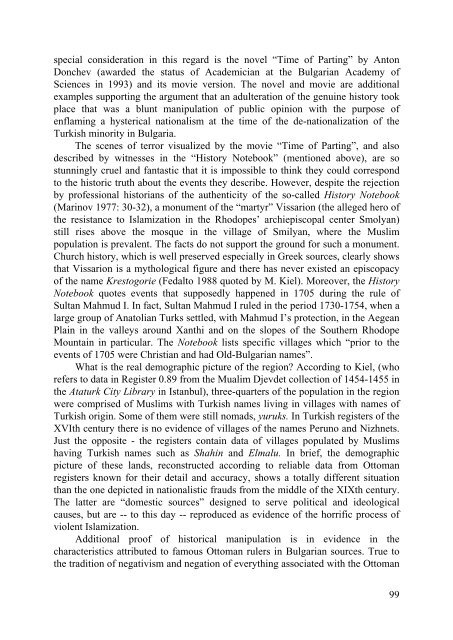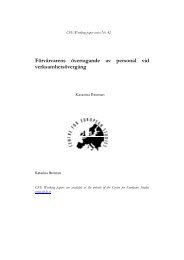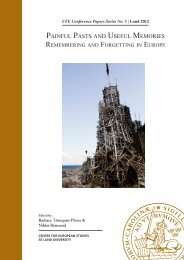MINNE OCH MANIPULATION - Centre for European Studies - Lunds ...
MINNE OCH MANIPULATION - Centre for European Studies - Lunds ...
MINNE OCH MANIPULATION - Centre for European Studies - Lunds ...
You also want an ePaper? Increase the reach of your titles
YUMPU automatically turns print PDFs into web optimized ePapers that Google loves.
special consideration in this regard is the novel “Time of Parting” by Anton<br />
Donchev (awarded the status of Academician at the Bulgarian Academy of<br />
Sciences in 1993) and its movie version. The novel and movie are additional<br />
examples supporting the argument that an adulteration of the genuine history took<br />
place that was a blunt manipulation of public opinion with the purpose of<br />
enflaming a hysterical nationalism at the time of the de-nationalization of the<br />
Turkish minority in Bulgaria.<br />
The scenes of terror visualized by the movie “Time of Parting”, and also<br />
described by witnesses in the “History Notebook” (mentioned above), are so<br />
stunningly cruel and fantastic that it is impossible to think they could correspond<br />
to the historic truth about the events they describe. However, despite the rejection<br />
by professional historians of the authenticity of the so-called History Notebook<br />
(Marinov 1977: 30-32), a monument of the “martyr” Vissarion (the alleged hero of<br />
the resistance to Islamization in the Rhodopes’ archiepiscopal center Smolyan)<br />
still rises above the mosque in the village of Smilyan, where the Muslim<br />
population is prevalent. The facts do not support the ground <strong>for</strong> such a monument.<br />
Church history, which is well preserved especially in Greek sources, clearly shows<br />
that Vissarion is a mythological figure and there has never existed an episcopacy<br />
of the name Krestogorie (Fedalto 1988 quoted by M. Kiel). Moreover, the History<br />
Notebook quotes events that supposedly happened in 1705 during the rule of<br />
Sultan Mahmud I. In fact, Sultan Mahmud I ruled in the period 1730-1754, when a<br />
large group of Anatolian Turks settled, with Mahmud I’s protection, in the Aegean<br />
Plain in the valleys around Xanthi and on the slopes of the Southern Rhodope<br />
Mountain in particular. The Notebook lists specific villages which “prior to the<br />
events of 1705 were Christian and had Old-Bulgarian names”.<br />
What is the real demographic picture of the region? According to Kiel, (who<br />
refers to data in Register 0.89 from the Mualim Djevdet collection of 1454-1455 in<br />
the Ataturk City Library in Istanbul), three-quarters of the population in the region<br />
were comprised of Muslims with Turkish names living in villages with names of<br />
Turkish origin. Some of them were still nomads, yuruks. In Turkish registers of the<br />
XVIth century there is no evidence of villages of the names Peruno and Nizhnets.<br />
Just the opposite - the registers contain data of villages populated by Muslims<br />
having Turkish names such as Shahin and Elmalu. In brief, the demographic<br />
picture of these lands, reconstructed according to reliable data from Ottoman<br />
registers known <strong>for</strong> their detail and accuracy, shows a totally different situation<br />
than the one depicted in nationalistic frauds from the middle of the XIXth century.<br />
The latter are “domestic sources” designed to serve political and ideological<br />
causes, but are -- to this day -- reproduced as evidence of the horrific process of<br />
violent Islamization.<br />
Additional proof of historical manipulation is in evidence in the<br />
characteristics attributed to famous Ottoman rulers in Bulgarian sources. True to<br />
the tradition of negativism and negation of everything associated with the Ottoman<br />
99




